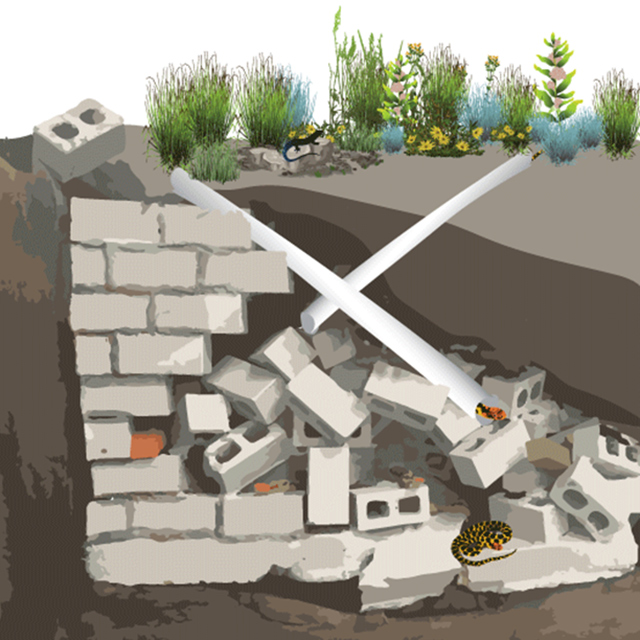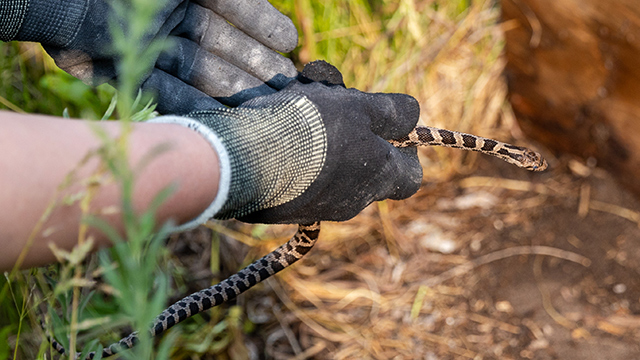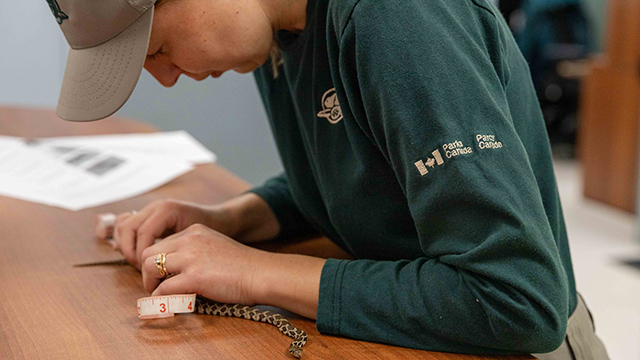Eastern Foxsnake monitoring
Point Pelee National Park
Foxsnake Hibernacula

To create a safe overwintering site, Parks Canada has constructed four artificial hibernacula throughout the park. Built from decommissioned old building foundations and old septic systems, the hibernacula provide snakes access to dry, safe holes below the frost line to spend the winter. To date, monitoring has shown several Eastern Foxsnakes have emerged from the newly constructed hibernation sites.
After emerging from a hibernaculum in the spring, female Eastern Foxsnakes are on the lookout for a place to lay their eggs. Female foxsnakes seek out nesting sites with high humidity to keep the eggs from drying out and to protect them from predators like raccoons. Natural sites, conducive to nesting, such as rotting cavities of fallen trees and abandoned rodent burrows, can be hard to find. In the winter of 2020, Parks Canada created some artificial nest areas for Foxsnakes. These artificial nest areas consist of decomposing leaf piles and woodchips near restored savannah sites where there is plenty of sun to keep the eggs warm. Monitoring activities have shown these have been successfully used by Eastern Foxsnakes including 22 eggshells found in 2022 and 77 in 2023!
Foxsnake Coverboard Monitoring

The Eastern Foxsnake is a species at risk classified as threatened federally and endangered provincially. Research and monitoring on Eastern Foxsnakes has been taking place in the park for decades, but these snakes are shy and hard to find. Snake Fungal Disease has been confirmed in several endangered Eastern Foxsnakes at Point Pelee. With this new threat, the importance of monitoring the Eastern Foxsnake population at Point Pelee is growing.
Point Pelee is contributing data to Ontario Nature's long-term monitoring program that aims to detect snake population trends over a ten-year period. Over time, it is hoped that this study will capture enough data to determine if the population is rising or falling in the park.

To do so, staff place several coverboards made of plywood in ideal foxsnake habitats in the park. These boards create a sheltered space that helps protect against the cold and extreme heat. This makes them very enticing for snakes and other reptiles. Throughout early may to mid-July, staff check underneath the coverboards for the presence of Eastern Foxsnakes. At times, they may also encounter skinks, other species of snakes, and other animals that take advantage of the cover.
Once a foxsnake is identified, staff wear gloves to capture and handle it for a while to give it time to feel comfortable. They then bring it back to the park office in a pillowcase that offers a dark, safe, breathable space, where it is examined in numerous ways.

First, staff compare the snakes’ skin patterns to others they have on record. Since this pattern is unique to each foxsnake, matching records means it is the same snake and won’t be counted twice. Other aspects that are included in the data are length, weight, sex, activity level, skin issues, and any signs of Snake Fungal Disease. Once everything is written down, staff return the foxsnakes to the exact coverboard they were found.
Monitoring populations and gathering data on foxsnake populations in Point Pelee National Park allow the Resource Conservation team to understand trends and determine if the population is rising or falling. This information then helps to make evidence informed decisions for conservation and restoration projects in the park.
Share your sightings!
If you see an Eastern Foxsnake during your park visit, report your sighting to the nearest park staff.
If you see an Eastern Foxsnake outside park boundaries, report your observations on the iNaturalist.ca mobile app.
Related links
- Date modified :